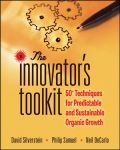
The innovator's toolkit: 50+ techniques for predictable and sustainable organic growth
Silverstein, David
INDICE: Part I. Define the Opportunity. Techniques and Tools For Identifying High-Potential Innovation Projects. TECHNIQUE 1. Jobs To Be Done. Determine the human need you're trying to fulfill. TECHNIQUE 2. Outcome Expectations. Give customers more of what they desire. TECHNIQUE 3. Value Quotient. Identify opportunity gaps in the marketplace. TECHNIQUE 4. Ethnography. Observe your customers to uncover unarticulated needs. Techniques and Tools for Scoping and Focusing Innovation Projects. TECHNIQUE 5. Heuristic Redefinition. Draw a picture of your system and its parts to focus ideation. TECHNIQUE 6. Nine Windows. Looking at your opportunity through nine different lenses. TECHNIQUE 7. Job Scoping. Broaden or narrow your innovation focus. Techniques and Tools for Effectively Managing People, Projects, and Innovation ROI. TECHNIQUE 8. Stakeholder Management. Get key influencers involved and on your side. TECHNIQUE 9. Cognitive Style. Leverage the diversity of your exploiters and explorers. TECHNIQUE 10. Project Charter. Keep your innovation team focused and on track. TECHNIQUE11. Innovation Financial Management. Constantly improve your assumption-to-knowledge ratio. Part II. Discover the Ideas. Techniques and Tools for Re ning Innovation Opportunities. TECHNIQUE 12. Resource Optimization. Make sure you use all available resources. TECHNIQUE 13. Functional Analysis. Scrutinize your system for innovation. TECHNIQUE 14. Trend Prediction. Learn from evolution's genetic code. TECHNIQUE 15. Creative Challenge. Sacrifice the sacred cows. Techniques and Tools for Leveraging Brainpower and Turbo-Charging Creativity. TECHNIQUE 16. HIT Matrix. Compare existing solutions to spark new breakthroughs. TECHNIQUE 17. Scamper. Ask eight important questions. TECHNIQUE 18. Brainwriting 6-3-5. Encourage equal opportunity ideation. TECHNIQUE 19. Imaginary Brainstorming. Get silly for the sake of creativity. TECHNIQUE 20. Concept Tree. Leverage current ideas to generate many ideas. TECHNIQUE 21. Random Stimulus. Usean unrelated picture or word to spawn new ideas. TECHNIQUE 22. Provocation and Movement. Step over the roadblocks in your thinking. Techniques and Tools for Exloring All Human Knowledge and Nature. TECHNIQUE 23. Structured Abstraction. Guide your innovation using 40 proven principles. TECHNIQUE 24. Separation Principles. Split your innovation problem in four ways. TECHNIQUE 25. 76 Standard Solutions. Learn how substances interact with fields to form solutions. TECHNIQUE 26 Biomimicry. Seek nature's eons of experience to find answers. Techniques and Tools for Selecting the Best Ideas for Further Development and Design. TECHNIQUE 27. KJ Method. Group and organize ideas by their natural affinities. TECHNIQUE 28. Idea Harvesting and Treatment. Organize and shape ideas to improve their yield. TECHNIQUE 29. Six Thinking Hats. Evaluate your solution ideas in six different ways. Part III. Develop the Solution. Techniques and Tools for Formulating an Initial Design. TECHNIQUE 30. Performance and Perception Expectations. Identify what customers want in your solution. TECHNIQUE 31. Axiomatic Design. Transform what customers want into the best products and services. TECHNIQUE 32. Function Structure. Identify how the solution functions in its whole and its parts. TECHNIQUE 33. Morphological Matrix. Generate solution concepts by combining design alternatives. TECHNIQUE 34. TILMAG. Pair ideal solution elements to create new design concepts. Techniques and Tools for Selecting the Very Best Design to Pursue. TECHNIQUE 35. Paired Comparison Analysis. Rank design concepts against each other in pairs. TECHNIQUE 36. Pugh Matrix. Evaluate all your design concepts to create the invincible solution. Techniquesand Tools for Optimizing and Finalizing Designs. TECHNIQUE 37. Process Capability. Predict the performance of your new solution. TECHNIQUE 38. Robust Design 223 Make your design insensitive to uncontrollable influences. TECHNIQUE 39 Design Scorecards. Develop a dashboard to track your design and its underlyingprocesses. TECHNIQUE 40. Design Failure Mode and Effects Analysis. Anticipatewhat can go wrong with your solution before it does. TECHNIQUE 41. Discrete Event Simulation. Visualize and test your innovation through computer modeling.TECHNIQUE 42. Rapid Prototyping. Make a fast 3D model of your solution to explore its viability. Part IV. Demonstrate the Innovation. Techniques and Tools for Evaluating How New Products/Services Perform Prior to Their Release. TECHNIQUE 43. Prototyping. Build a fully functioning model of your new product to test and perfect it. TECHNIQUE 44. Piloting. Build a fully functioning model ofyour new service to test and perfect it. Techniques and Tools for Mapping NewProduct and Service Delivery Processes. TECHNIQUE 45. SIPOC Map. Identify thekey inputs and outputs of your processes. TECHNIQUE 46. Process Map/Value Stream Map. Flesh out the details of your process. Techniques and Tools for Making Sure Processes Are Optimized for Efficient and Flawless Operations. TECHNIQUE 47. Measurement Systems Analysis. Make sure you know your measurements are valid. TECHNIQUE 48. Work Cell Design. Configure the workspace for flow and optimization. TECHNIQUE 49. Mistake Proofing. Install measures to prevent human and system error. TECHNIQUE 50. Design of Experiments. Analyze input and outputvariables to identify the critical few. TECHNIQUE 51. Conjoint Analysis. Compare solution attributes to cull out customer preferences. Techniques and Toolsfor Problem Diagnosis and Improvement Prior to Commercialization. TECHNIQUE 52. Process Behavior Charts. Monitor process performance to keep the new solution in control. TECHNIQUE 53. Cause & Effect Diagram. Investigate the root causes of performance problems. TECHNIQUE 54. Cause & Effect Matrix. Identify the key input-output relationships in need of attention. TECHNIQUE 55. Control Plan. Ensure that your new solution becomes commercialized as planned. Index.
- ISBN: 978-0-470-34535-1
- Editorial: John Wiley & Sons
- Encuadernacion: Cartoné
- Páginas: 384
- Fecha Publicación: 03/12/2008
- Nº Volúmenes: 1
- Idioma: Inglés
